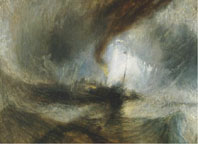 Turner and Wordsworth created embodiments of Burke's descriptions of sublimitythat make explicit his notion of a subjective, experiential world. urner's Snow Storm: Steamboat off a Harbour's Mouth (1842), one of the paintings in whose defense Ruskin began Modern Painters, plunges us into the midst of a storm at sea: the whirling vortex of water, sea-mist, and smoke draws us into the scene, making us look not at the storm but through it. The power, magnificence, obscurity, and awe of the Burkean formulation all present themselves as major components of the experience. But, again, the viewer, like the painter before him who immersed himself in the storm on the Ariel, does not see these qualities as qualities of an object or scene but as qualities of subjective experience. Furthermore, as Jack Lindsay has shown, Turner's similar early paintings, such as Snow-storm: Hannibal and his Army Crossing the Alps (1812), demonstrate the painter discarding earlier neoclassical schemes of composition in an attempt to fuse the elements of form, chiaroscuro, and color. "In their place he put a dynamic form of spiral, an explosive vortex, a field of force."[J.M.W. Turner: A Critical Biography (New York, 1966), 120].
Turner and Wordsworth created embodiments of Burke's descriptions of sublimitythat make explicit his notion of a subjective, experiential world. urner's Snow Storm: Steamboat off a Harbour's Mouth (1842), one of the paintings in whose defense Ruskin began Modern Painters, plunges us into the midst of a storm at sea: the whirling vortex of water, sea-mist, and smoke draws us into the scene, making us look not at the storm but through it. The power, magnificence, obscurity, and awe of the Burkean formulation all present themselves as major components of the experience. But, again, the viewer, like the painter before him who immersed himself in the storm on the Ariel, does not see these qualities as qualities of an object or scene but as qualities of subjective experience. Furthermore, as Jack Lindsay has shown, Turner's similar early paintings, such as Snow-storm: Hannibal and his Army Crossing the Alps (1812), demonstrate the painter discarding earlier neoclassical schemes of composition in an attempt to fuse the elements of form, chiaroscuro, and color. "In their place he put a dynamic form of spiral, an explosive vortex, a field of force."[J.M.W. Turner: A Critical Biography (New York, 1966), 120].
In other words, in place of the static composition, rational and controlled, that implies a conception of the scene-as-object, Turner created a dynamic composition that involved the spectator in a subjective relation to the storm. Similarly, certain passages in Wordsworth's Excursion, the poem which furnished the epigraph to Modern Painters, present us with the phenomenological world of sublime experience. Thus, although the poem frequently employs the term "sublime," mentioning, for instance, a "burst/Sublime of instrumental harmony," "unity sublime," and the "sublime ascent" of man's hopes, sublimity appears not so much in the use of the term as in the poet's presentation of sublime experience in the midst of a majestic dynamic natural scene of which the spectator becomes a part [Works, v, 146, 3n6, and 289].
Last modified December 2001